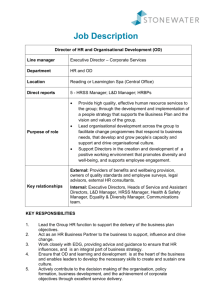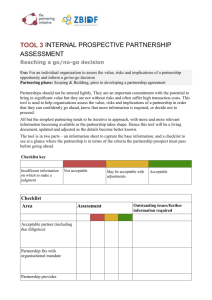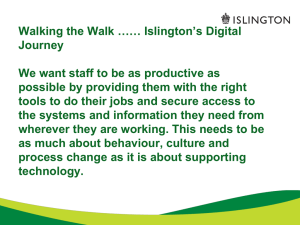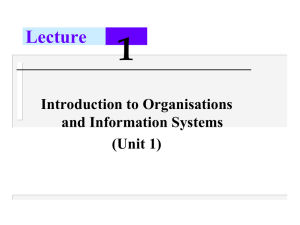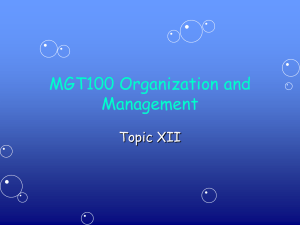Leaders Changing Culture
advertisement
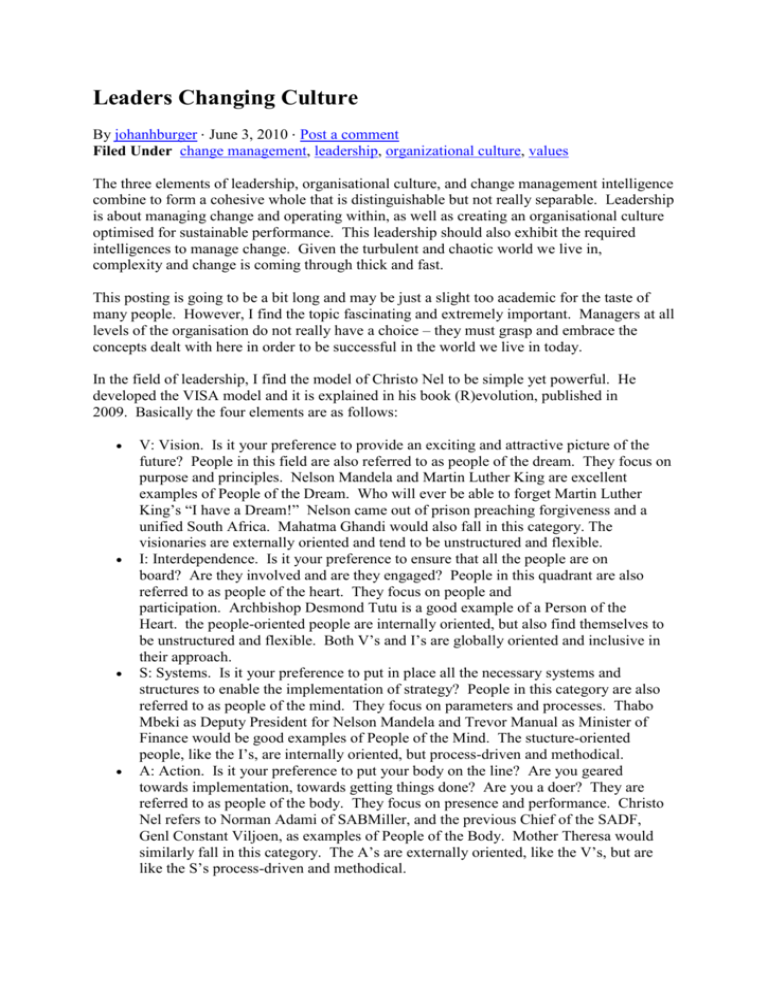
Leaders Changing Culture By johanhburger ⋅ June 3, 2010 ⋅ Post a comment Filed Under change management, leadership, organizational culture, values The three elements of leadership, organisational culture, and change management intelligence combine to form a cohesive whole that is distinguishable but not really separable. Leadership is about managing change and operating within, as well as creating an organisational culture optimised for sustainable performance. This leadership should also exhibit the required intelligences to manage change. Given the turbulent and chaotic world we live in, complexity and change is coming through thick and fast. This posting is going to be a bit long and may be just a slight too academic for the taste of many people. However, I find the topic fascinating and extremely important. Managers at all levels of the organisation do not really have a choice – they must grasp and embrace the concepts dealt with here in order to be successful in the world we live in today. In the field of leadership, I find the model of Christo Nel to be simple yet powerful. He developed the VISA model and it is explained in his book (R)evolution, published in 2009. Basically the four elements are as follows: V: Vision. Is it your preference to provide an exciting and attractive picture of the future? People in this field are also referred to as people of the dream. They focus on purpose and principles. Nelson Mandela and Martin Luther King are excellent examples of People of the Dream. Who will ever be able to forget Martin Luther King’s “I have a Dream!” Nelson came out of prison preaching forgiveness and a unified South Africa. Mahatma Ghandi would also fall in this category. The visionaries are externally oriented and tend to be unstructured and flexible. I: Interdependence. Is it your preference to ensure that all the people are on board? Are they involved and are they engaged? People in this quadrant are also referred to as people of the heart. They focus on people and participation. Archbishop Desmond Tutu is a good example of a Person of the Heart. the people-oriented people are internally oriented, but also find themselves to be unstructured and flexible. Both V’s and I’s are globally oriented and inclusive in their approach. S: Systems. Is it your preference to put in place all the necessary systems and structures to enable the implementation of strategy? People in this category are also referred to as people of the mind. They focus on parameters and processes. Thabo Mbeki as Deputy President for Nelson Mandela and Trevor Manual as Minister of Finance would be good examples of People of the Mind. The stucture-oriented people, like the I’s, are internally oriented, but process-driven and methodical. A: Action. Is it your preference to put your body on the line? Are you geared towards implementation, towards getting things done? Are you a doer? They are referred to as people of the body. They focus on presence and performance. Christo Nel refers to Norman Adami of SABMiller, and the previous Chief of the SADF, Genl Constant Viljoen, as examples of People of the Body. Mother Theresa would similarly fall in this category. The A’s are externally oriented, like the V’s, but are like the S’s process-driven and methodical. Figure 1: The VISA Model of Christo Nel Depending on your preferences, you would tend to exhibit some or other profile. There is no correct profile. Your profile just is. What is important is that your leadership team should exhibit all 4 the elements in a balanced manner. If there are no V’s in your team, your destination will be uncertain, while too much V will lead to exciting bankruptcy. If none of the executive team in your organisation has a preference for Interdependence, you are bound to pick up a few problems in the people side of your organisation. If you only have people in I, then you will go bankrupt but at least you will all be happy about it! No S’s in your team will lead to chaos as there will be no systems and organisation to guide action, while too much S will lead to precise bankruptcy! An absence of A will be an ideal world for the lazy amongst us, while too much A will lead to busy bankruptcy. As for organisational culture, we have a hoard of excellent work. Richard Barrett, Goffee and Jones, and Trompenaars are but a few examples of people who have done excellent work in this regard. I am also a fan of the work of Cameron and Quinn. They have developed the Competing Values Framework, which I will use here. The Adhocracy culture is the creative and innovative side. This is typically the culture that reigns supreme when a company is in the start-up phase. It is probably a requirement for the initial success of the company that it is close to the customer and consumer early in its life. I find the marketers in the organisation to fall in this quadrant. They have an external orientation. The Clan culture is strong on people and organisational culture. In the development of the start-up, it is the second phase of the development of the organisational culture. The Human Resource managers tend to fall in this quadrant. They also tend to have an internal orientation. The Hierarchy culture evolves after a while. It is necessary for the organisation to put in place the processes, procedures and policies to avoid chaos. Banks typically are strong on this as they work in a compliance environment. The finance people in the organisation tend to prefer this quadrant. Like the Clan people, these people also have an internal orientation. The Market culture is focussed on the external environment, and more specifically on the competitors and customers. The competitive situation is important for them. Normally I find the executive team to be strong in this quadrant. Figure 2: The Competing Values Framework of Cameron & Quinn The reason why Cameron and Quinn refer to this model as the competing values framework is because managers tend to see some of the elements as being on competing ends of a continuum. So the Adhocracy and the Hierarchy cultures will be in competition, as will the Clan and the Market cultures. This is not necessarily how it should work, as we can frequently find situations where we need systems and procedures as well as innovation and creativity. Cameron and Quinn are very clear on this as well. As was the case with the leadership profile, there is no correct culture. Whatever culture is appropriate given the people and the environment is the “correct” culture. An overemphasis on specific quadrants in an environment that is not conducive for such a culture could be detrimental to the sustainability of the organisation. If you are pedantic and inclined towards the hierarchy culture, whilst innovation and creativity is paramount and you ignore this requirement, then you could find your organisation to be in some trouble, to put it mildly. Should you be interested, Cameron and Quinn have written an excellent book on this topic and it also has the questionnaires for you to ascertain your current and desired culture. The book is “Diagnosing and changing organisational culture.” Changing organisational culture is something which takes a lot of time and effort, and requires buckets full of visionary leadership. It also requires the leader to tap into all the elements of the VISA model. You need to have a purpose, take your people along with you, put in place the processes and systems, and then make it happen. Should you not do this, the December scenario applies: “Commit suicide today and avoid the December rush!” In order to manage change, be it culture or not, change management principles apply. John Kotter and a host of other people have developed great models as to how to deal with change. Here I would like to deal with the intelligences required for change management. Cook, Macaulay, and Coldicott (2004) have identified 4 intelligences required to deal with change. Business Intelligence (BQ) involves business expertise/competence, the ability to think ahead strategically, to listen to and anticipate stakeholder needs, to plan to meet stakeholder demands, to develop stakeholder-driven offerings and solutions and operational processes, and to take opportunities to improve services to the stakeholder. BQ provides the rationale for change, the sound business case for moving forward, the credible drive and inspiration to others. The focus of BQ is external. Spiritual Intelligent (SQ) leaders have a high degree of self-confidence and selfawareness which enables them to set a clear direction and to stick firm to their course of action while not shutting out important new pieces of information. They have reflected deeply upon their life and purpose, their role goals and contribution, their value to the world, their personal growth, and their self-awareness. They have the personal resources to drive the formulation of strong and appealing organizational visions and values that influence the behaviours of others towards future goals. Their strength of conviction gives them the confidence to think outside the box and not to be afraid to do things differently. SQ entails the sense of purpose and the self-belief that leaders need in order to be steadfast in change. The focus of SQ is internal. Political Intelligent (PQ) leaders need to know how to influence others within the organization. In this regard, PQ involves being aware of power bases, understanding sources of power, recognizing levers of influence during change, developing strategies for influence, and gaining buy-in from stakeholders. PQ entails an understanding of stakeholder issues and concerns, networking and buy-in for change. The focus of PQ is internal. Emotional Intelligence (EQ) involves an understanding of your own and other’s feelings, to listen, to be open and empathic, to share your feelings, and to appreciate others. EQ relates to the quality of relationships between managers, their bosses, colleagues, and direct reports. EQ entails positive relationships. It provides nurturing qualities and creates positive team spirit. The focus of EQ as defined here is external. Cook et al. have developed various combinations of these 4 intelligences to form 4 quadrants. Order: PQ & BQ: These people are likely to project manage change with a clear idea of the use of resources. They weigh up people and business criteria objectively. They tend to be more comfortable handling known parameters than the unknown. Action: BQ & PQ: These people are pro-active and tend to have a short-term focus. They are likely to be impatient, for example if change gets blocked. They provide a strong sense of urgency. Nurture: EQ & SQ: These people are concerned to bring others with them and are strong on engaging others’ support. They may be reluctant to take decisions which adversely affect others. They have a visible ethical stance. Creativity: SQ & EQ: These people enjoy change that is new and different. They may find routine implementation dull. They have a clear, confident stance on their abilities and ideas. Figure 3: Leadership, Culture and Change (adapted from Nel, Cameron & Quinn, and Cook, et al.) The three elements of leadership, organisational culture, and change intelligence combine in a rather strong reinforcing manner. The following correlations seem clear: Vision Leadership (VISA Model), Adhocracy Culture (CVF), and Creativity Intelligence (Cook et al.). Here the purpose and dream of the Vision-oriented leader correlates with the creativity and innovation of the Adhocracy culture and the SQ and EQ of the Change Intelligences. Interdependence (VISA Model), Clan Culture (CVF), and Nurture Intelligence (Cook et al.). In this profile, the people oriented approach of the leader correlates with the people centredness of the Clan culture and the EQ and SQ of the Change Intelligences. Systems (VISA Model), Hierarchy Culture (CVF), and Order Intelligence (Cook et al.). In this profile, the parameters and processes of the System-oriented leader correlate with the processes and regulations of the Hierarchy culture and the PQ and BQ of the Change Intelligences. Action (VISA Model), Market Culture (CVF), and Action Intelligence (Cook et al.) the action orientation of the leader correlates with the external market orientation of the culture and the BQ and PQ of the Change Intelligences. This apparent correlation between the different models tells me that the respective models are inherently sound. They complement each other in a synergistic manner, which for a big fan of systems thinking such as myself is a thing of beauty. It is poetic! I must confess that I was tempted to bring in the different managerial approaches of Quinn, et al. but that would have complicated the picture even more. These managerial approaches of Quinn are strongly correlated with the Competing Values Framework of Cameron and Quinn. So let’s try and keep the issue simple. The type of organisational culture is more or less a choice (to a certain extent) and needs to be aligned with the ethos of the leadership, the employees, and the owners of the organisation. However, the leadership and intelligence elements all need to be present. Individuals would tend to be biased towards some or other profile. The leadership team should exhibit all the respective elements. Therefore, as Christo Nel so eloquently puts it, it takes a village of leaders to lead a company to prosperity and sustainability. The bottom line? Leadership is crucial. So is organisational culture. You need to be clear as to what your profile looks like. Should you want to change your organisational culture, or anything within your organisation such as strategy, you should also embrace the respective intelligences. They can be measured. Have you measured yours? If not, it is high time you do know what your profile looks like, both as an individual and as an organisation. It can only help you in your personal and organisational developmental interventions. http://johanhburger.com/leaders-changing-culture/




